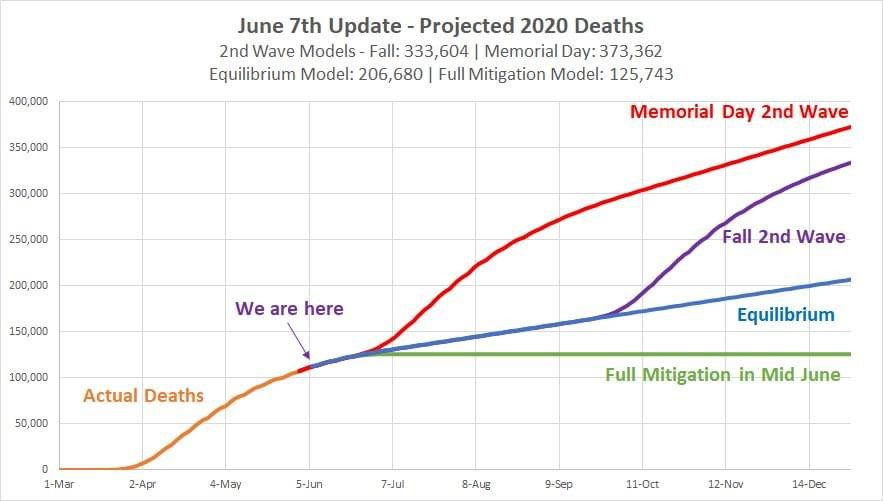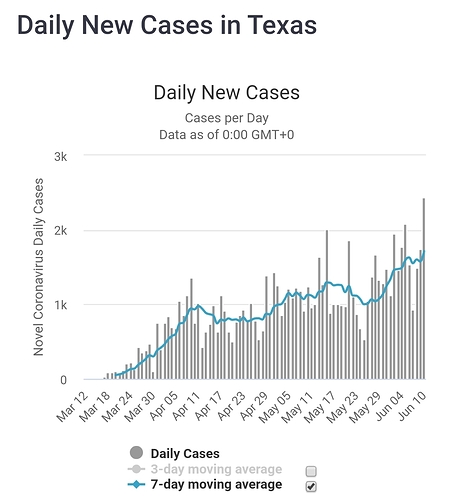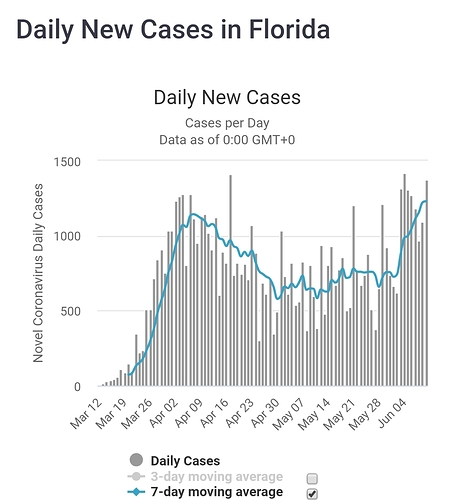I haven’t looked too closely, but I’ve heard some commentary that this study didn’t control for age, an obvious risk factor for both baldness and severe covid-19
My wife had a patient of about the same age die with the exact same scenario a couple weeks ago
Well I might be chunky but I have a beautiful thick head of hair for my age. Time to hit the bars.
No pulling punches here
I hope he dies
This is funny but sadly that is the kind of logic guiding this administration.
Update from the DC data modeler:
June 7th – When Do We See a Second Wave? Update
I’ve been getting a lot of questions about when we should expect to see new cases and new deaths as a result of state relaxation of mitigations, Memorial Day shenanigans, and/or the massive protests and counter-protests that have arisen as a result of the heinous murder of George Floyd. Short version is that we are just now entering the time frame where we might expect to be seeing effects from some of the re-openings, and it’s too early to see effects from Memorial Day or the protests - they should start showing up in the mortality data around the 4th of July. Because there are no consistent efforts in place to test asymptomatic individuals in the population, if there’s a new round of infections we won’t know until they start seeing folks show up in the hospitals. At that point it’ll already be much too late to contain a second wave.
tl;dr as always. Strap in, this update really sucks. I know they all kind of suck, but this one especially.
A few notes about what we understand about the virus to level set. Typical incubation period for COVID-19 is 5 days, with virtually everyone who gets symptoms showing them by day 11. About 80% of cases are understood to be mild or entirely asymptomatic. Infected individuals with minor symptoms or no symptoms individuals may not know they are sick and further may be completely unaware that they have been in contact with an infected person. These individuals are still infected and contagious but may not be taking steps to protect others. It is also believed to be the case that even during the pre-symptomatic phase, some people shed enough virus to be contagious. The upshot here is that THE OVERWHELMING MAJORITY OF INFECTED INDIVIDUALS HAVE NO IDEA THEY ARE CONTAGIOUS WHILE THEY ARE CONTAGIOUS. There is little scientific consensus on the overall mortality rate of COVID-19, with estimates between 0.25% and 1.5% being the most common.
Back to the question about when we will know if recent potential spread events result in new disease epicenters. The first thing to bear in mind is that most of the potential spread events involve younger people. Memorial Day parties are going to tend much younger than the general population. Polling suggests (mine and others) that younger people are far more likely to resume activities that more vulnerable populations might avoid. These include activities that are returning in various ways as states reduce mitigation rules such as going back to restaurants, bars, getting haircuts, etc. Finally, the people out at the protests also appear to be much younger on average than the general population. This isn’t to say that everyone at these events will be young, but it’s likely that more will be than a random draw from the population. These same demographics are the least likely to show up at hospitals or to end up dead – they also the most likely to be asymptomatic while contagious if infected.
As a result, the first wave of infections from a potential spread event are likely to originate from asymptomatic individuals and be spread to individuals among least likely to become symptomatic. It is probable, therefore, that this first new generation of spread will not create a sufficient number of symptomatic test requests, hospitalizations, or deaths to show up in reporting.
These newly infected individuals return to their homes and their daily lives unaware that they’ve been infected and will likely become contagious within a week with or without symptoms. They will be able to transmit the disease to anyone they come in contact with, but most effectively to the people they live with. This second generation of infections from the spread event will include a more representative swath of the population and those folks will start showing up in test cases, hospitals, and, unfortunately, the morgues. Before that happens though, they will also have an asymptomatic contagious period during which they will create a third generation of infections. The third generation creates a fourth and so on and this is pretty much what happened in the beginning phase of COVID-19 in the United States and led to the lockdowns.
The reproductive rate of COVID-19 appears to be 1.5 and 4 meaning that the average diseased individual infects that many new people if no precautions are taken to prevent it. In potential super spreader event scenarios, such as those we saw on Memorial Day or during the protests, the reproductive rate can be much higher. Consider the super spreader event in Washington state where a chorus met and, while they avoided personal contact and took a few other small mitigation methods, one infected individual managed to infect 52 people out of sixty in the span of two to three hours. Because they were in the space together for an extended period and singing (which aerosolizes the virus droplets and keeps them in the air longer), 87% of those attending the chorus practice become infected and two ultimately died.
Let’s imagine a realistic but hypothetical spread event. Let’s assume that at one of the large Memorial Day (May 25th) events there were 2,000 revelers interacting with limited mitigation. Let’s further assume that approximately 2% of attendees were infected and of those, half were contagious at this event meaning 20 contagious individuals. Let’s further assume a more conservative spread of 10 new cases per infected individual, much less than the 50 in the Chorus example where people were probably spending more time with the same infected individual. Please don’t get too hung up on the assumptions, this is just to help understand the math of the spread. Spread could be considerably less or more depending on conditions. Finally, let’s assume a mortality rate of 0.75%
In this example we have 200 new infections (1st gen) on May 26th who will become contagious in about five days on average. Because of the demography described above, very few will develop any symptoms, probably less than 10% (20) and of those, symptoms may be minor with zero mortality or close to it. By May 31, these 200 infected individuals become contagious and, because mitigation efforts within households is very rare, will begin to infect their families, roommates, friends, etc. If we assume an average reproductive rate of 3, there will be an additional 600 cases (2nd gen) between June 5th and June 11th. This group will start to become contagious on June 10th and spread to an additional 1,800 people (3rd gen) who will start getting sick around June 16th. At this point, people in the second generation will start showing up for testing and in hospitals. This would be the time that communities would, one hopes, start contact tracing and quarantines to reduce the reproductive rate of the virus. Around June 19 the first noticeable increases in COVID-19 deaths would start to occur from the 2nd generation. About a week later the deaths from the 3rd generation would start to appear. Assuming mitigation efforts get the reproductive rate down to two infections per infected individual after folks start showing up in hospitals, we would see an additional 3,600 infected people in the 4th generation around June 21st who will become contagious around June 26th. It is at this point (June 26-July 1) when the increase in death rates should start showing up from the 3rd gen and will begin to look like a statistically valid increase. In that single month, excluding the initial 200 in the first generation of the new outbreak, there will have been 6,000 new cases of whom about 45 will eventually die. Until and unless additional mitigation efforts are undertaken, this number will double weekly.
Some events were bigger than this hypothetical and most were smaller, but there were hundreds of Memorial Day events across the country. By the time we catch up to what happened with testing or mortality, it would be far too late to prevent a secondary wave. The scale of that wave would be dependent on mitigation efforts still in effect and by sensible behavior among the population such as mask wearing.
The protests have been occurring at massive levels, with the Washington Post reporting at least 650 events nationally, some with tens of thousands of participants. Each of these are potential super-spread events (see last week’s update).
Three early states that relaxed mitigation were Georgia (April 24th), Texas (May 1st), and Florida (May 18th). Georgia has yet to see an impact (good or bad) on new cases or deaths which is great news if it lasts. In contrast, Texas has seen a nearly constant increase in their daily new cases since reopening but has yet to see a change in deaths as would be expected given the timing. Florida is faring about the same as Texas, both of which are now experiencing their highest counts of daily new cases since the beginning of the pandemic. If death rates follow suit, we should expect to see a critical increase in mortality before the end of June. Compared to areas where mitigation efforts were not relaxed (or relaxed much later), both daily new cases and deaths have dropped precipitously. These include New York, New Jersey, Massachusetts, and Pennsylvania.
By this logic, if we are seeing new spread, we should see noticeable increases in daily deaths regionally from re-openings in some states within the next two weeks. By the 4th of July we should see regional spikes related to Memorial Day events across the country if those events caused spread. The protests, if they are a source of spread, will show up in mortality data around the 15th of July.
The problem we face right now, is that these are all events that HAVE ALREADY HAPPENED. There is nothing we can do about them. Even ignoring the actions of the states to reopen, Memorial Day/protests spreads will be in their 5th or 6th generation before mortality data becomes clear from the data. That’s far too late for any form of containment to be possible through contact tracing or quarantine. The same is true for the protests. The only tool that will be left in the playbook for stopping the spread if we have a new wave will be to reengage broad closures and orders to stay at home. Those will take at least a month to work if followed. The additional death toll to this second wave could be in the tens of thousands based on the models I’ve been publishing.
So, we can watch the numbers, make sure we’re not part of these new generations by wearing our masks and distancing, but it’s already too late to do anything about stopping them. If these events have initiated a new spread of COVID-19 we’re ALREADY in the middle of it. That’s also why the “Memorial Day 2nd Wave” mortality projection is still so far away.
So, stay home when you’re able, don’t do risky things that could infect yourself or others, think about how your actions affect those around you, and dig in for a long haul. Hopefully this will all be irrelevant, and we’ll have few if any super-spreader events, but I’m not sure that’s our most likely scenario at this point.
PLEASE stay home. PLEASE wear a mask. PLEASE act like you don’t want your neighbors and loved ones to contract the virus. Please, please, please.
For the protesters out there trying to make needed societal change in this terrible pandemic, I’m going to end by repeating my recommendations for protesting from last week. Please stay safe and remember that you are a potential health threat to your family and friends when you come home. Do what you need to do to keep everyone safe.
EDIT: Forget to mention, as I always do, that I’m not a medical professional or epidemiologist, just a guy that’s passable good at math. If what I say conflicts with actual experts (like Dr. Fauci) believe them, not me. Seriously.
Unfortunately this makes a lot of sense.
So, when California secedes it will turn into a couple Dakotas?
Why is this guy predicting the second wave to start up in October?
It looks like on his graph it starts in July?
Think his graph takes into account different mitigation efforts. There’s some background in his previous updates. I have a few of them I’d be happy to post but they’re dated, of course.
One of the graphs has it starting in July because of a possible Memorial Day effect. Not sure what’s the cause of an October resurgence in the other scenario.
Texas really trying to make an impression and get their very own MAGA rally.
Need to step their game up to keep pace with:
We went from 724 to 803 in one day . We have doubled every week for a month from 78 to like 180 last week . We are at about 180 this week and almost 100 local partiers (20-50 years olds ) have it .
Great summary. Key point -by the time it’s obvious it’s too late.
Really good to map the generations of a new wave. And it all lines up so that the 3rd and 4th cycles line up with OFB and more relaxation than ever.
The Bay Area and exactly the Bay Area has done this well in the US. Seattle responded well to the initial tragedy.
These are great, thanks for posting. I feel like he does a really good job of synthesizing all the stuff we’ve talked about itt for months.
Although if he thinks a protest with masks or Memorial Day pool party could be a super spreader event - I’d hate for him to see my gym a few hours ago (and now I’m sure). For the record since the thread moves so fast - I did not go in, saw the packed parking lot and a ton of people not wearing masks in the window and turned around.
I can also think of a bunch of potential mitigation factors to the second wave that may or may not matter:
- Better treatments, less usage of ventilators
- Some herd immunity
- Some of the most vulnerable (grandmas living in blue collar households) have already gotten it
- Summer temps/humidity could mean milder cases
- The virus may have already mutated to a milder strain
- More precautions could lead to generally milder initial doses
- Protesters and Memorial Day partiers might be more careful around parents and grandparents than back in Feb/March
- Minority communities who may have tuned it out back then should take it more seriously now. (According to Van Jones there was a rumor going around the black community for a while that black people were immune.)
That’s just off the top of my head. It seems like most factors should make a second wave less severe. But then again if the second wave is 3x the first wave, it could overwhelm all that.
It’s not our fault we have all the real working immigrant families living in tight family clusters and you have all the rich douchebags disrupting manscaping devices and ED pill delivery.
I read this the to other day about a dude who has a long hard recovery ahead of him.
https://www.washingtonpost.com/health/2020/06/09/coronavirus-ventilator-rehabilitation/?arc404=true
Then, physicians began to notice that the lungs of some covid-19 patients responded differently than the lungs of typical patients suffering from “acute respiratory distress syndrome.” Speculating that ventilation was being overused in the pandemic, they began to use the machines more sparingly. They also adopted other, less invasive methods, such as turning patients on their stomachs to help them breathe more easily. The debate over ventilation persists in the medical community.
There is also research evidence that pure oxygen can be corrosive to lungs and other tissue. The air we breathe is only about 20 percent oxygen. And lying in an ICU, unconscious and paralyzed by powerful drugs, is harmful by itself.
There is no good data on how many people have been placed on ventilators during the pandemic. Studies on the number who survive vary widely. Early reports out of China and elsewhere suggested a mortality rate of about 90 percent, and some U.S. studies put it at about 80 percent.
But more recently, doctors who work extensively with covid-19 patients on ventilators have said 50 percent to 80 percent recover.
Jacqueline Stewart, a 56-year-old psychiatric nurse, spent four weeks on a ventilator before she was discharged to Burke for rehab. She arrived “deconditioned,” essentially unable to move on her own, with nerve damage in her right arm, probably from her position in the ICU bed. She has a raspy voice from a paralyzed vocal cord and what she calls her “battle scars” — marks on her neck from an intravenous line and a tracheotomy. She vowed never to cover them with makeup.After weeks of physical therapy, Stewart went home May 29. There are 20 steps up to her front door in Yonkers. Burke would not allow her to leave until she proved she could climb 20 steps in the hospital.
@Will1530 I’m curious to get your take on this.


